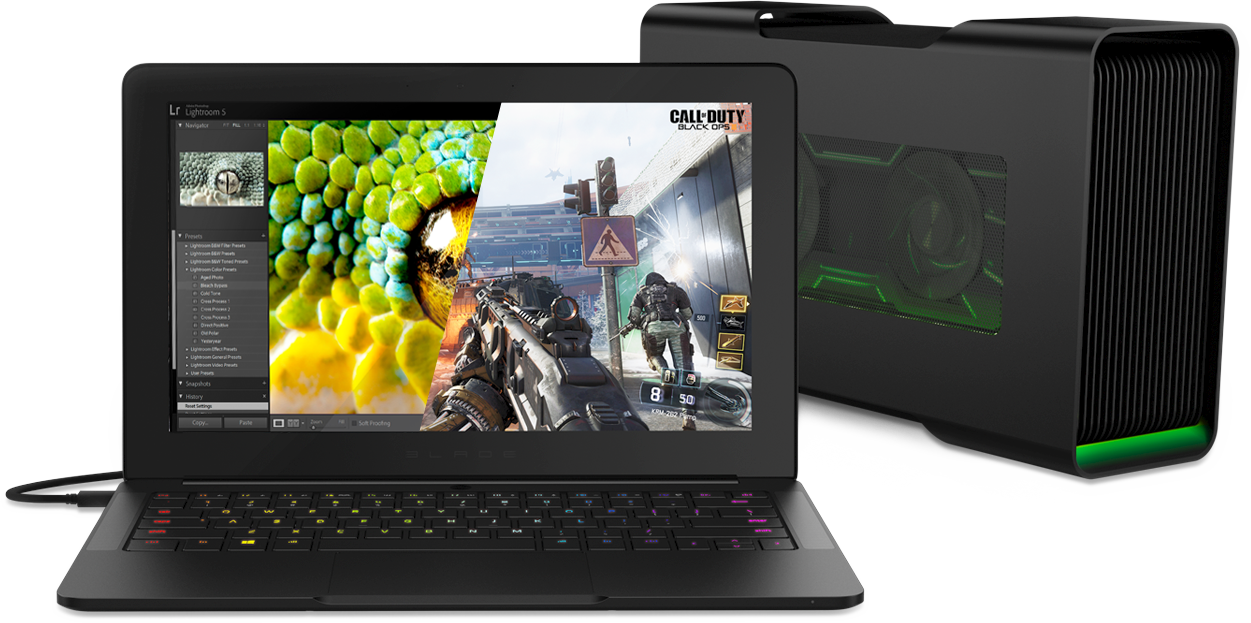
Desktop-level graphics performance has been something of a Holy Grail for laptop buyers and makers alike, with many, many solutions cluttering the dustbin of notebook history. Trendsetter Razer believes it’s finally found the right combination that can alternatively offer maximum portability or beefy graphics.
At the recently completed CES, the gaming device company showed off its latest laptop, the Blade Stealth Ultrabook. As the Ultrabook designation suggests, it’s a lightweight, skinny system that should be easy to carry along. While it’s reasonably powerful as far as notebooks go — Intel Skylake Core i7 processor, 8GB of RAM, choice of 2,560×1,440 or 3,840×2160 (4K) 12.5-inch display — it relies on integrated graphics that, though greatly improved with each iteration of the Core architecture, won’t please gamers or content creators (image and video editors, etc.). That’s always been the rub for mobile computers, but Razer hopes it has a new take on an old solution that can satisfy the demands for better graphics performance.
That solution is an external graphic card connected to the laptop to boost graphics while the computer is being used at a desktop. It’s been tried many times before — and without much success, whether due to the awkward setup or lackluster performance. But notebook manufacturers haven’t given up yet, thanks to the development of Intel’s Thunderbolt technology, particularly the latest version, Thunderbolt 3. Thanks to the swift transfer speeds capable via the USB Type C connector, the external graphic card for laptops is getting a fresh look, with Acer, Dell, and HP all showing off new laptops at CES that include a Thunderbolt 3 port.
Razer goes one further and offers something to plug into that USB Type C port. The Core is an enclosure with a Thunderbolt 3 connection that, according to the company, can house nearly any desktop graphics card that AMD or Nvidia is currently offering. The card can be attached to the aluminum enclosure via a single screw, and the card can be accessed by the Stealth Blade without require a reboot with compatible cards. With up to 40Gbps throughput, the Thunderbolt 3 connection can move data from the card at significantly faster rates than previous attempts at these types of solutions (a USB 3.0-based one would max out at 5Gbps in comparison).
The Core also doubles as a port replicator, featuring four USB 3.0 ports and an Ethernet connection on its rear, and includes a 500-watt power supply to juice up the inserted card. In typical Razer fashion, the enclosure has a stylish design complete with neon green accent lighting. But the potential breakthrough in performance is the story here: If the Core can truly get the maximum out of today’s powerful cards, it could finally fulfill the promise of past attempts at external graphics glory. Then again, maybe gamers and power users still won’t rush out to get a box that’s bigger than the notebook it’s designed to support, preferring to game on their desktop PCs or content to schlep around a heftier laptop with discrete graphics built into it.
The success of the Core enclosure could definitely hinge on its price point — since a graphics card doesn’t come with it, it shouldn’t cost hundreds and hundreds of dollars, though it probably won’t cost $50, either. (Alienware’s Graphics Amplifier is currently selling for $199, though that’s $100 less than when it launched late in 2014.) Unfortunately, Razer hasn’t disclosed the pricing yet for the Core, which it says will become available sometime in the first half of 2016. On the other hand, the Blade Stealth Ultrabook will start at $999 for its base configuration when it starts shipping this month.
Do you have any interest in an external graphics card enclosure for your laptop? What would you pay for the Razer Core? Let us know your thoughts in the Comments section below.


